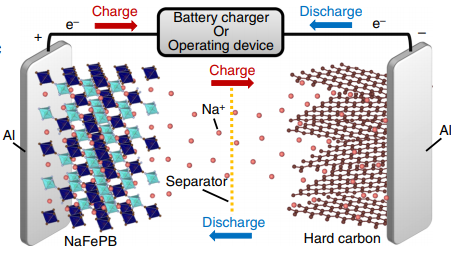
Event date:
May
20
2021
11:30 am
Material for Sodium ion batteries Prussian blue Analogue Nanocubes Supported on MOF Derived MnO2@C Nanorods as High-Capacity Cathode
Supervisor
Dr. Irshad Hussain
Student
Roheen Saeed
Venue
Zoom Meetings (Online)
Event
MS Thesis defense
Abstract
Modern society is challenged by the demand of prompt energy transition to renewable resources and electric transport while facing continuously increasing adverse effects of the greenhouse gases. The intermittent nature of sustainable energy resources has triggered the efforts to develop energy storage systems to bring a balance between energy production and utilization. Among the various energy storage technologies, lithium-ion batteries (LIBs) have made remarkable progress in electronic devices and wearable electronics. However, this technology is still inadequate for high energy storage systems such as batteries for electric vehicles owing to their high cost, limited resources and low specific capacity. In this regard, aqueous rechargeable sodium-ion batteries are the cost effective and environmental benign alternatives of the expensive and hazardous, organic based lithium-ion batteries which leads to the exploration of various types of sodium-based electrode materials including single transition metal oxides, binary metal oxides, ternary metal oxides, polyanionic compounds such as phosphates, sulphates, pyrophosphates, and fluorophosphates of transition metals. Despite of remarkable achievements in this area, the commercialization of aqueous rechargeable sodium-ion batteries is limited due to the challenges associated with the development of desired electrode materials including their limited specific capacity, rapid fading of capacity upon battery cycling and low shelf-life. The development of novel and more efficient electrode material is, therefore, highly desired to make this emerging technology more commercially viable.
Keeping the aforementioned challenges in view, we have developed efficient cathode material by supporting nanocubes of Prussian blue analogue i.e., NiCoPBA on the surface of highly conducting MOF derived MnO2@C, the synthesized material has been characterized by PXRD, SEM, EDX, IR, ICP-OES and TGA etc. The synthesized cathode material exhibits high reversible capacity of about 180 mAhg-1 at the current density of 100 mAg-1 between the voltage range of (-1 - +1) with high-rate capability and excellent cyclability with 95% capacity retention after 100 cycles.
Keeping the aforementioned challenges in view, we have developed efficient cathode material by supporting nanocubes of Prussian blue analogue i.e., NiCoPBA on the surface of highly conducting MOF derived MnO2@C, the synthesized material has been characterized by PXRD, SEM, EDX, IR, ICP-OES and TGA etc. The synthesized cathode material exhibits high reversible capacity of about 180 mAhg-1 at the current density of 100 mAg-1 between the voltage range of (-1 - +1) with high-rate capability and excellent cyclability with 95% capacity retention after 100 cycles.
Link: https://lums-edu-pk.zoom.us/j/93320055066?pwd=ZDFWcnRkbTgzWTJiekhEcGxaa0dHZz09
Meeting ID: 933 2005 5066
Passcode: 021605

